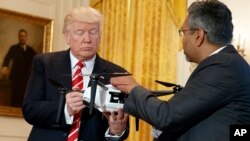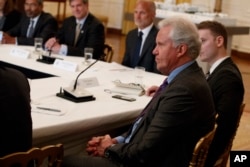Ubiquitous drones and a faster Internet are coming sooner than you might think, and governments are staring into the unknown as they face the prospect of regulating the coming technological revolution in a way that fosters innovation, while at the same time protecting the often conflicting interests of consumers, entrepreneurs and the general public.
It’s Technology Week at the White House, and top industry executives huddled together Thursday with President Donald Trump to show off their wares and talk about what government’s role should be in regulating, and at the same time encouraging the pace of change. The discussion was all about “next generation” lightning-fast 5G wireless services and the exponential growth of drone-related technologies.
“This meeting comes at an important time because we’re on the precipice of moving to 5G and bringing about the Internet of Things,” said Mike Sievert, Chief Operating Officer of T-Mobile, a leading cellphone service provider. “The position that the government takes is going to determine whether or not America continues to lead in technology.”
Sievert was joined by a Who’s Who of top executives from venture capitalists and firms such as Sprint, AT&T, General Electric, Honeywell, Verizon, and Microsoft. Also attending were entrepreneurs from drone industry leaders like AirMap, which produces a platform for drone mapping that is in use at most U.S. airports; and Precision Hawk, which analyzes data gathered by advanced drone technology and sensors for the energy and agriculture industries.
Trump told the group he is committed to keeping the government out of the way to allow the tech companies to grow and prosper.
“[There have been] too many years of excessive government regulation,” Trump told the drone executives. “We’ve had regulation that’s been so bad, so out of line, that it’s really hurt our country. On a daily basis, we’re getting rid of regulation.”
Enabling innovation
Trump’s message did not appear to go down well with the entrepreneurs, however. Precision Hawk CEO Michael Chasen explained to the president the need for government to take a lead role in establishing rules and standards for the drone industry.
“This is the one industry where we need a little bit more regulation,” Chasen told Trump. “Because the default [present state of affairs] is limiting what drone technology can do and we need the FAA and other regulatory bodies who have the power to regulate [to open] up those opportunities so we can stay competitive with other countries.”
Trump said his government wants to provide an environment where innovators can dream big.
“We’re on the verge of new technological revolutions that could improve virtually every aspect of our lives, create vast new wealth for American workers and families and open bold new frontiers in science, medicine and communications,” said the president.
Drone industry experts say sales growth has been phenomenal.
“In the past eight months, nearly 850,000 drones were registered by the FAA [Federal Aviation Administration],” said Brett Velicovich, president of a Washington area drone firm and author of the new book Drone Warrior. "That compares to only 350,000 airplanes sold over the past 100 years."
Drone concerns
Velicovich said his greatest worry is that governments such as the United States don’t seem to fully appreciate the potential security threat posed by the new generation of cheap, powerful drones in the hands of terrorists.
“Groups like ISIS see how cheap this technology is and how capable it is and how far they can fly away from the remote and the type of payloads you can put on it and so the security implications come from these people and organizations that would try and do us harm,” he told VOA. “They see how readily available the technology is, how cheap it is, and how far it’s come just in the last few months.”
The United States has long been a leader in the use of military drones, and a multi-billion-dollar drone sale is reported to be up for discussion early next week when India’s Prime Minister Narendra Modi pays a visit to the White House.
Reuters reports that India is pushing to buy a naval variant of the Predator drone, which manufacturer General Atomics says can be used for wide-area, long-endurance maritime intelligence, surveillance and reconnaissance missions. It can stay in the air for up to 27 hours and can fly at a maximum altitude of 15,000 meters.








